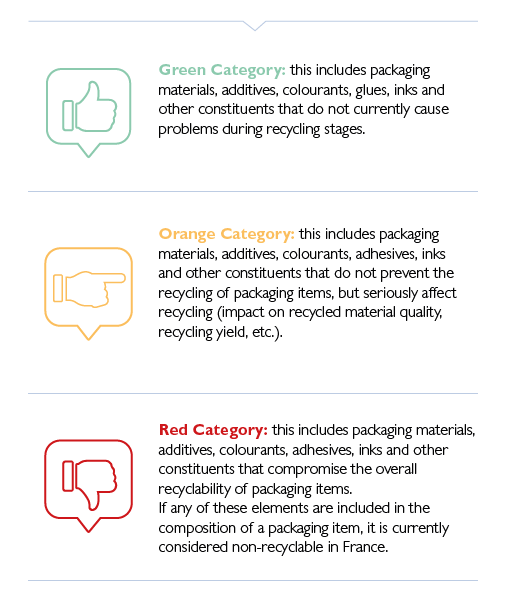ASSESSING YOUR PACKAGING
How to assess the recyclability of your paper and cardboard packaging
Changes have been made to French regulations to encourage companies to check the recyclability of their packaging. This step will become mandatory in 2030: “Manufacturers who put at least 10,000 product units on the market every year and declare a turnover of more than €10 million will have to justify that the waste generated by the products they manufacture, market or import can be recycled within one of the recycling streams (Article 61 of the French AGEC law).”
CEREC provides tools and methods to help you ensure that your paper and cardboard household packaging is recyclable.
1. Establishing the characteristics of the packaging to be assessed.
The recyclability of a paper/cardboard packaging item involves looking at the packaging “as sorted by consumers” with the help of the sorting instructions included on the packaging. The packaging includes all the elements that might remain together when consumers sort it after the product it contains has been consumed: it therefore consists of a main element and associated elements* (e.g. a cardboard tray will be assessed with its lid and label, a carton with its screw cap, etc.).
*Elements that are mechanically attached, i.e. glued, thermo-welded, laminated, screwed, fixed, etc., to the main element, or elements that are not mechanically attached but remain with the main element because they do not need to be separated from it for the product to be consumed. In exceptional cases, CEREC reserves the right to include certain packaging, for which an associated element may lead the paper and cardboard content to be under the allowed threshold, in the paper and cardboard stream.
To find out more about how Sorting Info encourages consumers to separate elements, click here!
2. Checking whether your packaging is part of the paper/cardboard packaging stream
Packaging is classed as being paper/cardboard packaging if paper and cardboard account for over 50% of the packaging’s weight.
Please remember that this threshold does not mean that the packaging is systematically recyclable in the paper and cardboard stream. In exceptional cases where an associated element may lead the paper and cardboard content to be under the permitted threshold, CEREC reserves the right to include that packaging in the paper and cardboard stream.
*Definition of paper/cardboard as a material:
Material made of natural cellulose fibres and fillers.1*
Any other fibres, including synthetic ones, incorporated into the paper/cardboard material will be considered part of that material under the following conditions: the proportion of natural cellulose fibres contained in the paper and cardboard remains greater than or equal to 50% in weight AND the other fibres behave similarly to the natural cellulose fibres during the recycling process.
The following are not considered part of paper/cardboard as a material:
- Substances or materials applied to the surface, such as finishes, coatings (including mineral-based), inks2*, varnishes and lamination.
- Other elements contained in the paper and cardboard (such as synthetic fibres, non-defibrated plant matter or regenerated cellulose).
- Adhesives (glues).
1*Fillers added to the surface of the material are not counted as part of the material. By default, we can consider that mineral fillers will be processed and recycled with the natural fibres, and will be added to the numerator when calculating the recyclability rate, unless the fillers are recognised as being part of the waste materials
2* Inks are included when calculating the theoretical recyclability rate of the paper/cardboard packaging, but are not a constituent of paper and cardboard, unlike mineral fillers. Inks are therefore not included in the weight of the paper and cardboard used as a numerator to identify the main packaging material.
PAPER AND CARDBOARD PACKAGING ARE DIVIDED INTO TWO CATEGORIES :
 Laminated paper and cardboard packaging
Laminated paper and cardboard packaging
Refers to paper/cardboard combined with one or more layers of different materials :
Paper/cardboard packaging which has at least one of its paper/cardboard sides completely covered with another material:
– which is closely bound or glued in such a way that the packaging has to be recycled using a specific process,
OR
– the proportion of which is over 15 % of the weight of the paper/cardboard substrate material.
Such packaging is recycled as laminated paper and cardboard.
Non-laminated paper and cardboard packaging
A paper/cardboard packaging item that does not meet the criteria associated with laminated paper and cardboard packaging is classed as non-laminated paper and cardboard packaging.
Such packaging is recycled as non-laminated paper and cardboard.
E.g. a cardboard box with a plastic window will need to comply with the 50% cardboard threshold but not the 15% criterion, as it does not have one of its sides completely covered in plastic resin.
3. Confirming that your packaging is compatible with the paper and cardboard packaging recycling stream
CEREC assesses the recyclability of a paper/cardboard packaging item by looking at the elements, materials, treatments, etc., which are placed into one of three categories:

All currently known elements have been classed according to the recyclability table drawn up by CEREC.
The matrix is subject to change as it reflects the current state of knowledge, which is based on scientific data, processing technologies currently available and the stream’s quality standards.
Other criteria have to be check in addition to the recylability table :
- Maximum reject criteria : For a packaging with a rate of theoretically recoverable material near 50%, we recommend you make another test according to the CEREC methodology, in order to check if the reject rate is less than 50%, another condition to claim that a paper-board packaging is recyclable.
- Handsheet quality with the test protocol
- Other requirements must be met to avoid stream pollution. For example, if the synthetic fibres disrupt the subsequent paperand cardboard manufacturing and transformation process, or do not meet the requirements for food-contact packaging, the initial packaging containing these synthetic fibres will not be considered as recyclable in the paper and cardboard stream. Another point are the mineral oils, which are prohibited in inks for packaging applications.
Tools & resources to help you to go further…

